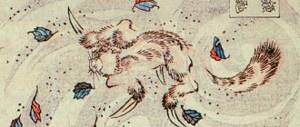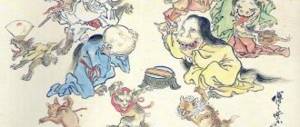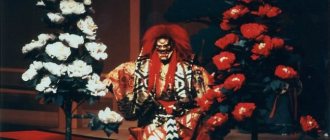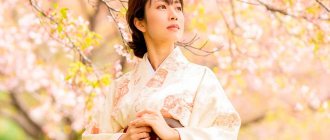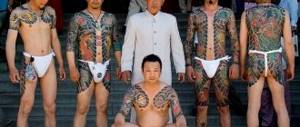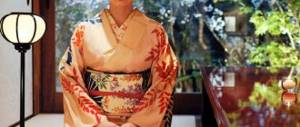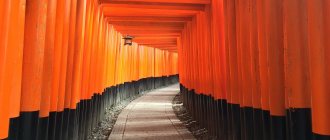Good afternoon friends! Since we started the topic of evil spirits, in this post we’ll talk about the horrors that haunt the Japanese. Every nation has its own horror stories, urban legends, forest evil spirits, ghosts and the like. I’ll try to collect all the Japanese horror in one place. Supernatural creatures of Japanese mythology are called yokai 妖怪, and there are so many of them that the list can be endless. One type of youkai is yurei 幽霊 - ghost, otherworldly spirit. They are scary because this species, unlike other characters of Japanese mythology, is closer to our perception and represents the spirit of dead people, that is, ghosts, ghosts, but more on that later.
Japanese mythology is very intricate and multifaceted, its origins were formed in ancient times and the first mention of youkai appeared in the first century. In the subsequent written monuments of Japan “Kojiki”, “Nihon Shoki”, “Shoku Nihongi” one can find mention of youkai. The close connection of Buddhism with the Shinto religion has given rise to a huge number of mythical and otherworldly creatures, which have no analogues in any mythology in the world.
Youkai are not only terrible and dangerous creatures, among them there are those who bring good luck. History tells that many Shinto gods - kami at different times passed into the state of youkai and returned back to the form of kami. I don’t dare talk about everyone, but the most prominent representatives will visit this page.
What are yokai or Japanese ghosts?
Yokai are, in Japanese mythology, supernatural creatures. Translated into Russian this means a ghost, a ghost, a monster. The concept of yokai includes all the diversity of the Japanese other world. All youkai are primarily spiritual beings rather than physical beings. Therefore, their common trait is weakness to spiritual attacks, spells, talismans, and so on. At the same time, they are practically not vulnerable to physical attacks, i.e. youkai cannot be killed. Nevertheless, youkai still die sooner or later; their life expectancy is much longer than that of a human.
Yokai are something that has undergone supernatural changes, they can change shape and it can be not only a humanoid creature, but also an animal, and even a thing. The Japanese believe that over time a thing can acquire life and intelligence. A good example: kasa-obake - an old umbrella that turns into a one-eyed and one-legged demon because the owners forgot about it or bake-zori - old sandals, such sandals become youkai after reaching 100 years of age if the owners took poor care of them and forgotten in the pantry. Having turned into youkai, bake-zori wander around the house at night and hum a creaking song.
Some of the pictures were taken from the Internet, the source is not signed, as they are posted on many sites and it is impossible to determine the original source. Some of the photographs are personal.
kasa-obake
Katakirauwa
This creature appears in the form of a black piglet or an adult black pig. It usually has only one ear, sparkling eyes of a reddish color, and does not cast shadows.
It is believed that katakirauwa appears only in large populated areas, and this happens exclusively at night.
A scary black animal runs under people's feet and takes their souls. A person who falls victim to such a monster turns into a terrible zombie.
In return for the stolen soul, the demonic pig leaves its likeness in his body. To save your soul, you must hop on one leg.
Mythical creatures
Japan has a large number of animals that have been attributed with supernatural abilities since time immemorial. Some of them are very popular to this day. Temples and cities are decorated with sculptures of tanuki and kitsune; it seems the Japanese sincerely believe in their magical abilities. Many films and anime are devoted to this topic. Let's start with the most popular werewolf animals:
- Kitsune means fox in Japanese. So much has been told and shown about this youkai that, probably, in every corner of the world they know about the insidious beauty of the fox. Kitsune rightfully takes first place in the list of mythical animals of Japan. In Japanese mythology, kitsune is the messenger of the god Inari; I talked about the trip to the Fushimi Inari Temple here. The evening walk between the sacred torii and kitsune sculptures made an unforgettable impression. But the Japanese idea of kitsune was additionally mixed with Chinese folklore, according to which the fox represents a class of werewolves; it is a clear representative of demonic force. In this context, kitsune is translated as “fox spirit” and does not imply a physical (not living) state, but something else ephemeral. Kitsune is able to take on the form of a person, often in the form of a beautiful girl. Her thoughts are evil, she can drive a person crazy, confuse, and destroy. Have you heard the joke why the Japanese always say “moshi-moshi” when talking on the phone? There is a belief that a kitsune cannot pronounce this combination of sounds, so a person knows for sure that at the other end of the line it is not a werewolf, but a person. The wisest and most insidious is the kitsune with nine tails; every hundred years she grows an additional tail. In some legends, kitsune have vampire qualities that feed on the spiritual and life force of a person. A separate story can be written about the kitsune, but it is certainly the most beloved folklore character.
- Tanuki is also a very beloved werewolf by the Japanese - a raccoon dog. Their small (and sometimes large) figurines can be seen almost everywhere, but especially often near drinking establishments, because tanuki are very fond of sake. He is considered a master of disguise and is mostly depicted with a hat on his head. He is good-natured (for the most part) and brings happiness and prosperity.
these animals along the railway greet tourists in Kyoto
and this is in night Kusatsu
- Bakeneko is one of the three most popular werewolves in Japan - a werecat. Not every cat becomes a bakeneko, but if you come across a cat with a long tail, a very large one (that weighs more than 3.75 kg) or a cat over 13 years old, then beware, it may not be a cat anymore. The werecat is not always a friendly creature; there are cases when she ate her owner and took on his image so that no one would suspect the disappearance of the first one. There are varieties of bakeneko, so a cat with a forked tail is called a nekomata. The nekomata is an evil youkai that devours people. Although it is believed that in ancient times it was the prototype of some kind of predatory animal, possibly a dwarf tiger. Bakeneko, like kitsune, mainly takes the form of a girl, but most often it is the spirit of a dead woman who has returned to take revenge on her offender. The abilities of a werecat include: changing shape and image, walking on its hind legs and dancing, speaking in a human voice, cursing people, bewitching them, manipulating dead people. They say that if a bakeneko jumps over a dead person, he will come to life. Myths and superstitions even today force the Japanese to give preference to cats with short tails; in some regions, if they decide to adopt a cat, they know exactly how many years it will live at home and after a certain time they get rid of it. But if you look at Japanese cities and streets, you generally get the impression that cats are loved here. In Japan there is a whole cat island called Aoshima, where there are 6 times more cats than people.
Hokkaido cats
- Okami is a wolf, a messenger of the kami gods; its prototype is a subspecies of the Japanese wolf, exterminated during the Meiji period. This youkai, unlike those listed above, does not bring evil; he understands human speech and knows how to look into people’s souls. Okami warns people about natural disasters, as was the case before the flood of 1889 and the great earthquake of 1923. It protects fields from trampling by wild boars. If a traveler returns late through the forest, he invisibly accompanies him home and protects him from disaster. In the event that an accident occurs to a traveler, an okami comes to his house and announces death with a plaintive howl. Cases are described where Okami raised a human baby. Okami is not a werewolf and does not transform into humans. The Japanese are very respectful of okami and wear fangs and other things as amulets, making offerings in Shinto shrines built in honor of the guardian wolf.
- Tsuchigumo are giant spiders with the face of a man, the body of a tiger and the legs of a spider. These evil youkai live in the mountains, attack people and eat them. There is a legend that Minamoto no Yorimitsu (948-1021) and his people met a strange creature in the mountains of Kyoto and began to pursue it. Climbing into the mountains, they saw a large number of youkai who began to attack the warriors. By morning, a beautiful woman appeared who tried to deceive them with affection, but Yorimitsu did not succumb to the spell and hit the woman with a katana. The woman disappeared, leaving behind white blood. Following the trail, the warriors reached the top of the mountain and discovered a huge spider in a cave, and a long battle began. Yorimitsu cut off the spider's head and ripped open its stomach, revealing the remains of 1,990 missing people.
- Inugami is a dog spirit, dangerous and cruel. This youkai is made by a man himself, apparently no less cruel. In order to summon an inugami, you need to bury a dog up to its neck, place a bowl of food in front of it that it cannot reach, and when it is completely exhausted from hunger, cut off its head. Then bury it at a busy intersection. After the time has passed, dig it up again and take it to a special temple. After this, the owner can summon the spirit of the inugami. This youkai is used for killing, causing bodily harm, and with the special skill of the owner, the spirit can inhabit a person and drive him crazy. But this is a dangerous undertaking, since the inugami is not predictable and, instead of the intended goals, can take revenge on the owner himself.
- Tengu is literally a heavenly dog, an image that comes from Chinese mythology. At first, the tengu was depicted with the characteristics of birds of prey, so it is often represented as a tall man with a red face and a long nose, with wings over his shoulders. He is often depicted in the robes of Yamabushi hermit monks. The image of the tengu has been known since ancient times and until the 12th century it was an evil spirit that always brought misfortune and instigated wars. He brought confusion into the minds of believers by transforming himself into Buddha, taking monks and boys far into the mountains, upon their return they were close to insanity and death. Starting from the 12th century, the image of the tengu began to grow with positive features, now it became a spirit with fighting skills, those who were lucky enough to receive a lesson from him, in the future became a great warrior. In the 17th century, the image of the tengu became associated with the image of the protector of Buddhist temples and forests.
- And another popular monster is the kappa, a Japanese merman, river child. It is something between a frog, a turtle, and often a monkey. Instead of a nose there is a beak, there are membranes on the hands, and the hands are connected to each other and by pulling one hand you can pull out the other. There is short hair on the head, and on the top of the head there is a small saucer filled with water - the life force of the kappa. The kappa is depicted with both a shell on its back and hair like a monkey. There are several versions of the origin of the kappa, one of which says that the owner killed a maid because she broke a saucer and threw it into the sea; the girl’s body became the prototype of the kappa. According to another version, kappa are drowned child thieves. Kappa is an evil youkai, he steals kimonos and deceives people, but his pranks do not end there, he lures people into the river and drowns them or sucks out their vitality after which people die. He loves to wander among people, wrestle with them, and loves sumo. It is physically impossible to defeat the kappa, but given that he is polite, people use the trick of bowing deeply to him, to which they receive the same deep bow in response and... that’s it, the water pours out of the saucer and the kappa loses its power. They say that if a person fills a saucer with water, the kappa will serve that person forever. Kappa also has positive characteristics: if he makes friends with people, he can help irrigate farmers' land, he knows many recipes for potions, he brings fresh fish to people and this is considered a sign of good luck for the one who received it. But in general, even today, when people want to talk about the dangers of swimming in bodies of water, they draw a mouthguard on posters.
Tanuki
First of all, we should talk about the creatures that are called “Tanuki” or raccoon dog. This is a powerful creature that actually lives in Japan and, as its name suggests, looks like a cross between a raccoon and a dog. But the folklore version of the tanuki is much more harmful and scary.
If you have ever been or are planning to travel to Japan, you will undoubtedly come across statues of big-eyed, chubby, friendly-looking creatures. These are modern tanuki, friendlier than the creatures of the past. Tanuki used to be tricksters who had the ability to shapeshift and stretch their massive scrotums. Images of tanukis show them using this organ for everything from improvised swimming aids to creating fearsome grimaces.
Demons and ghosts
On February 3, Japan celebrates the holiday Setsubun, this is the day between winter and spring, by celebrating, the Japanese banish the evil spirit of Oni. Since ancient times, there has been a belief that they are cannibalistic demons, horned, fanged, with red, blue or green skin, they have always caused horror among people. They live in Jigoku, or, to put it simply, an analogue of Japanese hell and are essentially demons (devils). They are evil and cunning, practically invincible, since severed body parts instantly grow back. They can turn into a person and often in order to destroy him.
Initially, it was an invisible evil spirit that brought disasters and diseases; in translation, oni means secretive, invisible. Gradually they became anthropomorphic and took the form that we see to this day.
Over time, they have lost some of their anger and cruelty and have minor protective characteristics. Thus, at festivals, men wear Oni outfits to protect the process from trouble. Despite the gloom of history, the Japanese celebrate the festival of expulsion of Oni with pleasure and fun, which suggests that all the terrible stories and myths in the modern world become just a fascinating fairy tale.
The next creepy class of youkai is the yurei - the spirit of dead people. Basically they are good-natured, with the exception of those who remained in this world to take revenge on their offenders and turned into mononoke.
Mononoke is an incarnate spirit, evil, he does not find peace due to strong emotions and connection with this world. As a rule, these are people who died a violent death or suicide. Jealousy, resentment, unfinished business, revenge drive them and it is not always possible to break this circle so that the soul calms down and leaves for another world. Mostly women appear in the form of mononoke, wanting to take revenge on the man who killed them. The goal of such yurei is one - murder. Mononoke have great power and only an Ayakashi (supernatural creature) can cope with them.
Akaname
This is a “dirt-licking” bath spirit that looks like a humanoid frog. In some cases he is red-skinned, red-faced.
Such a creature personifies the fear that visits superstitious people in dark non-residential premises at night. At night, Akaname cleanses unwashed containers, bathrooms and public baths from various contaminants.
You should not take a bath immediately after being licked by this creature, otherwise you may get sick. Thus, Akaname demonstrates that hygiene rules cannot be neglected, otherwise it will greatly affect health.
How to say in Japanese - feelings and emotions expressing fear
Between reading creepy stories, let's friends remember the words that fit the moment. These Japanese words can be used when you are feeling terrified to communicate your emotions:
- The simplest and most common word from the horror category is 怖い / こわい / kowai - scary, frightening. This word is used when one is afraid of someone or something. Moreover, this word can be scary if a linguistic error is made. We remember very well that in Japanese a word is both pronounced and written (and vice versa). It is not permissible to replace sounds during pronunciation, as is customary in the Russian language. Moreover, there are many words in which, when replacing one sound in a word, a diametrically opposite meaning appears. For example, they wanted to say something nice to a girl: 可愛い / かわいい / kawaii - pretty, sweet, but they faltered and said - こわい / kowai - scary, I think yes, the consequences will be terrible.
- 恐ろしい / おそろしい / osoroshii - terrible, terrible, ominous. Example: 昨夜恐ろしい夢を見ました。/ Sakuya osoroshī yume o mimashita. — Last night I had a terrible dream.
- when, after reading scary stories, you go to drink tea and trip over a cat in the dark, you will shudder with horror, it will be ぞっとする / Zotto suru (tremble, shudder)
- In other words, you can describe your fear and horror: 背筋が凍る / せすじがこおる / Sesuji ga kōru - the spine is frozen, that is, it is scary to the point of numbness. Or horror that clots the blood - ちもこおる / Chi mo kooru
- 恐怖 / kyo:fu fear, dread. 恐怖する / kyo:fusuru - to be scared. 恐怖症 / きょうふしょう / Kyōfushō, and this is already a phobia. These words explain psychological, irrational fear.
- ぐろい / Guroi - disgusting as hell, so much so that it bothers you.
- another way of saying that fear gives you goosebumps 鳥肌が立つ / とりはだがたつ / Tori hada ga tatsu
- Probably everyone has at least once experienced a situation (at least in a dream) when, numb with fear, your legs become weak and it is impossible to move. In Japanese, this state can be expressed by the phrase 足が竦む / あしがすくむ / Ashi ga sukumu - legs numb with fear.
- 肝を冷やす / kimoohiyasu - to be terrified. 肝 / きも - translated into Russian - liver (organ), 冷やす - to freeze. As an important organ, the liver is often used in Japanese idioms to show how serious a situation is. By saying this phrase you are showing how scared you are to do something.
- 忌まわしい / Imawashī - sinister, disgusting.
Ubume
Ubume is a creature that appears in the form of a pregnant woman, naked to the waist. From the waist down, her clothes are stained with blood. She holds in her arms a baby wrapped in swaddling clothes.
Ubume walks the streets and persuades people she comes across to take the baby in their arms. When someone agrees and takes the child from a woman, she immediately disappears somewhere.
Then the baby begins to rapidly grow heavier until it becomes a rock or a heavy boulder.
It is believed that women who die during childbirth turn into ubume. To prevent transformation, you need to remove the dead child from the womb and bury the doll with the woman. She will replace the unborn baby.
Yorogumo
According to legend, when a spider reaches the age of 400 years, she gains magical powers and can take the form of a seductive woman. It is said that Yorogumo plays the lute in a hut in an abandoned forest, thereby attracting his victims, who follow the sounds of beautiful music. While the victim listens in fascination to the sounds of the lute, the creature wraps him in its web, thereby providing food for itself and its offspring.
Gorbachev is 90! “He who dances to jazz will regret it tomorrow”: quotes from the leader of the USSR
The fight against drowsiness and daydreaming: forecast from Vasilisa Volodina for the week
Black monochrome and oversized jacket: stylish looks from Instagram stars for March 2021
Onryo
2. Onryo are spirits that were treated unfairly during life. Now their rage does not allow them to find peace. Perhaps the most famous onryo is Oiwa, whose fate is depicted in a Kabuki play called Yotsuya Kaidan.
The story begins with Oiwa's husband killing her father, his father-in-law, because he learned of his past sins. Then a rich neighbor, upon meeting, tells his husband that his young and beautiful granddaughter is in love with him. “What a shame that you can’t marry her!” – adds the neighbor. After this, the villain tries to poison his wife. The poison does not kill Oiwa, but it does horribly disfigure her features. When she sees her reflection in the mirror, she understands what her husband is up to. It breaks her heart. Oiwa dies, unable to bear the mental anguish.
Time passes, and the widower marries his neighbor's granddaughter. At the wedding, he lifts his bride's veil and sees Oiwa's face. In horror, the man beheads her with a sword and only then realizes that this is his new wife. Since then, the disfigured face has haunted the poisoner everywhere. He burns the bodies of his ex-wife and her father and goes on the run, but is overtaken by Oiwa's brother, who seeks revenge and kills the scoundrel.
Ubume
Tsukumogami
Tsukumogami is a general term for household items that have gained a soul and personality. Thus, tsukumogami are things that come to life. They are generally portrayed as kind creatures, but according to legend, items that are thrown away or misused become vengeful towards their previous owners.
Step-by-step recipe for making a delicate dessert: fragrant pomegranate cakes
Lungs, heart and more: what people who have recovered from Covid should check
A beautiful soft ottoman is easy to make with your own hands: simple instructions
Futakuchi-onna
Futakuchi-onna looks like an ordinary woman, however, she has a huge mouth hidden under her hair on the back of her head. A woman's skull may fall apart, revealing teeth and a long tongue. The female monster uses her hair as tentacles with which she grabs food and places it in her second mouth.
In most folklore stories, futakuchi-onna was the wife of a miser who starved her to death. As a result, the woman grew a second mouth.
Found a violation? Report content
Kappa
Humanoid reptiles called kappas are said to inhabit Japanese ponds and rivers. The appearance of the kappa is indeed very unusual. It looks like both a frog and a turtle and has a beak. In addition, this creature always carries a bowl of water with it, and if the water is poured out of this vessel, the magical creature loses its magical powers.
As a rule, the kappa is an evil creature, but it is distinguished by its politeness. If a passerby bows to them, they step back and bow back, causing the water to pour out of their cup. If this passerby fills the kappa's cup, they will become friends and allies for life.
Still, you should beware of this creature related to Japanese mysticism. According to legends, kappa drown children, drink the blood of their victims, and also sexually assault women.
There are three things that Kappas are obsessed with. The first is cucumbers, the second is sumo wrestling and the third is the desire to take possession of the stone that contains the human soul.
Nuppeppo
The word "nupper" is a slang term used to describe a woman who wears too much makeup. Nupeppo is a creature that looks like a piece of rotten meat with sagging features. Folklore describes them as harmless creatures. However, something should be said about their disgusting smell, which reeks of rotting flesh.
They usually appear at night near cemeteries and temples. Some sources say that whoever can catch the fast-moving creature will kill it and eat the disgusting flesh, gain eternal youth or be cured of a serious illness.
